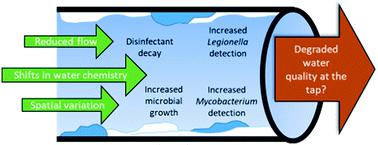当前位置:
X-MOL 学术
›
Environ. Sci.: Water Res. Technol.
›
论文详情
Our official English website, www.x-mol.net, welcomes your feedback! (Note: you will need to create a separate account there.)
Drinking water microbiology in a water-efficient building: stagnation, seasonality, and physicochemical effects on opportunistic pathogen and total bacteria proliferation
Environmental Science: Water Research & Technology ( IF 5 ) Pub Date : 2020-08-17 , DOI: 10.1039/d0ew00334d Christian J. Ley 1, 2, 3, 4 , Caitlin R. Proctor 1, 2, 3, 4, 5 , Gulshan Singh 4, 6, 7, 8, 9 , Kyungyeon Ra 2, 3, 4, 5 , Yoorae Noh 2, 3, 4, 5 , Tolulope Odimayomi 1, 2, 3, 4 , Maryam Salehi 4, 10, 11, 12 , Ryan Julien 4, 13, 14, 15 , Jade Mitchell 4, 13, 14, 15 , A. Pouyan Nejadhashemi 4, 13, 14, 15 , Andrew J. Whelton 1, 2, 3, 4, 5 , Tiong Gim Aw 4, 6, 7, 8, 9
Environmental Science: Water Research & Technology ( IF 5 ) Pub Date : 2020-08-17 , DOI: 10.1039/d0ew00334d Christian J. Ley 1, 2, 3, 4 , Caitlin R. Proctor 1, 2, 3, 4, 5 , Gulshan Singh 4, 6, 7, 8, 9 , Kyungyeon Ra 2, 3, 4, 5 , Yoorae Noh 2, 3, 4, 5 , Tolulope Odimayomi 1, 2, 3, 4 , Maryam Salehi 4, 10, 11, 12 , Ryan Julien 4, 13, 14, 15 , Jade Mitchell 4, 13, 14, 15 , A. Pouyan Nejadhashemi 4, 13, 14, 15 , Andrew J. Whelton 1, 2, 3, 4, 5 , Tiong Gim Aw 4, 6, 7, 8, 9
Affiliation

|
The rising trend in water conservation awareness has given rise to the use of water-efficient appliances and fixtures for residential potable water systems. This study characterized the microbial dynamics at a water-efficient residential building over the course of one year (58 sampling events) and examined the effects of water stagnation, season, and changes in physicochemical properties on the occurrence of opportunistic pathogen markers. Mean heterotrophic plate counts (HPC) were typically lowest upon entering the building at the service line, but increased by several orders of magnitude at the furthest location in the building plumbing. Legionella spp. and Mycobacterium spp. were detected in the plumbing, with the highest detection occurring in the summer months. Log-transformed HPC were significantly correlated with total cell counts (TCC) (rs = 0.714, p < 0.01), Legionella spp. (rs = 0.534, p < 0.01), and Mycobacterium spp. occurrence (rs = 0.458, p < 0.01). Reduced water usage induced longer stagnation times and longer stagnation times were weakly correlated with an increase in Legionella spp. (rs = 0.356, p < 0.001), Mycobacterium spp. (rs = 0.287, p < 0.001), TCC (rs = 0.216, p < 0.001) and HPC (rs = 0.395, p < 0.001). Interrelationships between seasonal shifts in water chemistry and genus-level genetic markers for opportunistic pathogens were revealed. This study highlights how drinking water microbiology varies seasonally and spatially throughout a low-flow plumbing building and highlights the possible unintended consequences associated with reduced water usage and increases in stagnation.
中文翻译:

节水建筑中的饮用水微生物学:停滞,季节性和物理化学对机会病原体和细菌总数增殖的影响
节水意识的提高趋势导致节水电器和固定装置用于住宅饮用水系统。这项研究描述了一年中节水型住宅建筑中的微生物动力学特征(58个采样事件),并研究了水停滞,季节和理化性质变化对机会病原体标记物发生的影响。在服务线进入建筑物时,平均异养菌板数(HPC)通常最低,但在建筑物管道中最远的位置增加了几个数量级。军团菌属 和分枝杆菌spp。在管道中被检测到,最高的检测发生在夏季。对数转化的HPC与总细胞计数(TCC)显着相关(r s = 0.714,p <0.01),军团菌属。(r s = 0.534,p <0.01)和分枝杆菌属。发生(r s = 0.458,p <0.01)。用水量减少导致更长的停滞时间和更长的停滞时间与军团菌属菌种的增加呈弱相关。(- [R小号= 0.356,p <0.001),分枝杆菌属。(r s = 0.287,p <0.001),TCC(r s = 0.216,p <0.001)和HPC(r s = 0.395,p <0.001)。揭示了水化学的季节性变化与机会病原体的属水平遗传标记之间的相互关系。这项研究强调了整个低流量水管建筑物中饮用水微生物的季节性和空间变化,并强调了用水量减少和停滞增加可能带来的意想不到的后果。
更新日期:2020-10-02
中文翻译:

节水建筑中的饮用水微生物学:停滞,季节性和物理化学对机会病原体和细菌总数增殖的影响
节水意识的提高趋势导致节水电器和固定装置用于住宅饮用水系统。这项研究描述了一年中节水型住宅建筑中的微生物动力学特征(58个采样事件),并研究了水停滞,季节和理化性质变化对机会病原体标记物发生的影响。在服务线进入建筑物时,平均异养菌板数(HPC)通常最低,但在建筑物管道中最远的位置增加了几个数量级。军团菌属 和分枝杆菌spp。在管道中被检测到,最高的检测发生在夏季。对数转化的HPC与总细胞计数(TCC)显着相关(r s = 0.714,p <0.01),军团菌属。(r s = 0.534,p <0.01)和分枝杆菌属。发生(r s = 0.458,p <0.01)。用水量减少导致更长的停滞时间和更长的停滞时间与军团菌属菌种的增加呈弱相关。(- [R小号= 0.356,p <0.001),分枝杆菌属。(r s = 0.287,p <0.001),TCC(r s = 0.216,p <0.001)和HPC(r s = 0.395,p <0.001)。揭示了水化学的季节性变化与机会病原体的属水平遗传标记之间的相互关系。这项研究强调了整个低流量水管建筑物中饮用水微生物的季节性和空间变化,并强调了用水量减少和停滞增加可能带来的意想不到的后果。



























 京公网安备 11010802027423号
京公网安备 11010802027423号